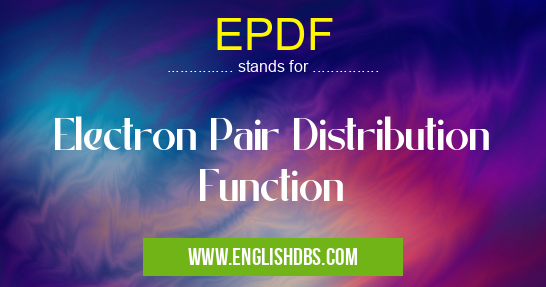What does EPDF mean in UNCLASSIFIED
Electron Pair Distribution Function (EPDF) is a powerful tool used in materials science to analyze the local structure and bonding of materials. It provides information about the spatial arrangement of atoms, including their bond lengths, bond angles, and coordination environments.

EPDF meaning in Unclassified in Miscellaneous
EPDF mostly used in an acronym Unclassified in Category Miscellaneous that means Electron Pair Distribution Function
Shorthand: EPDF,
Full Form: Electron Pair Distribution Function
For more information of "Electron Pair Distribution Function", see the section below.
Introduction to EPDF
EPDF Meaning and Significance
EPDF is a function that describes the probability of finding two electrons at a particular distance from each other. It can be obtained from experimental data, such as X-ray or neutron scattering experiments. By analyzing the EPDF, researchers can gain insights into the atomic-level details of materials, such as:
- Bond Lengths: The peaks in the EPDF correspond to specific bond lengths between atoms.
- Bond Angles: The relative intensities of the peaks can provide information about bond angles.
- Coordination Environment: The shape and width of the peaks can reveal the coordination environments of atoms, such as the number and types of nearest neighbors.
Applications of EPDF
EPDF is widely used in various fields of materials science, including:
- Crystallography: Determining crystal structures and defects.
- Amorphous Materials: Characterizing the local structure of glasses and liquids.
- Nanomaterials: Studying the structure and bonding of nanoparticles and other nanostructures.
- Phase Transitions: Identifying changes in the atomic-level structure during phase transformations.
Essential Questions and Answers on Electron Pair Distribution Function in "MISCELLANEOUS»UNFILED"
What is the Electron Pair Distribution Function (EPDF)?
The Electron Pair Distribution Function (EPDF) is a mathematical function that describes the probability of finding a pair of electrons at a given distance apart in a material. It is a powerful tool for understanding the structure and bonding of materials at the atomic level.
How is the EPDF measured?
The EPDF can be measured experimentally using a technique called X-ray or neutron diffraction. In these techniques, a beam of X-rays or neutrons is scattered by the electrons in the material, and the resulting scattering pattern is used to calculate the EPDF.
What information can be obtained from the EPDF?
The EPDF can provide a wealth of information about the structure and bonding of a material, including:
- The average distance between atoms
- The coordination number of each atom
- The bond lengths and angles
- The presence of defects and disorder
How is the EPDF used in materials science?
The EPDF is used in a wide variety of materials science applications, including:
- Understanding the structure and bonding of new materials
- Characterizing the microstructure of materials
- Studying the effects of processing and heat treatment on materials
- Investigating the properties of materials at the atomic level
What are the limitations of the EPDF?
The EPDF is a powerful tool, but it does have some limitations. These include:
- The EPDF is an average over all the electrons in a material, so it cannot provide information about the bonding of individual atoms.
- The EPDF is sensitive to noise and artifacts, so it can be difficult to obtain accurate results for materials with complex structures.
Final Words: EPDF (Electron Pair Distribution Function) is a valuable technique that provides detailed information about the local structure and bonding of materials. It allows researchers to probe the atomic arrangements in various materials, helping to understand their properties and behavior.
EPDF also stands for: |
|
| All stands for EPDF |
